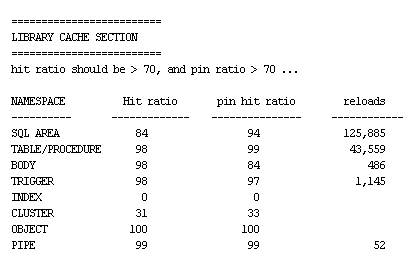| Lesson 8 | Viewing the library cache statistics |
| Objective | Determine library cache misses and parse calls for SQL. |
Viewing the Library Cache Statistics
Add Space to shared pool
Library Cache Misses
Library cache misses occur during the compilation of SQL statements. The compilation of a SQL statement consists of two phases:
Within the library cache, hit ratios can be determined for all dictionary objects that are loaded. If any of the hit ratios fall below 75 percent, you should add to the shared_pool_size. These include:
- Parse phase: When the time comes to parse a SQL statement, Oracle first checks to see if the parsed representation of the statement already exists in the library cache. If not, Oracle will allocate a shared SQL area within the library cache and then parse the SQL statement
- Execute phase: At execution time, Oracle checks to see if a parsed representation of the SQL statement already exists in the library cache. If not, Oracle will re-parse and execute the statement.
Within the library cache, hit ratios can be determined for all dictionary objects that are loaded. If any of the hit ratios fall below 75 percent, you should add to the shared_pool_size. These include:
- Table/procedures
- Triggers
- Indices
- Package bodies
- Clusters
Library cache activity
The table V$LIBRARYCACHE is the V$ table that keeps information about library cache activity.| Namespace | Indicates whether the measurement is for the SQL area, a table or procedure, a package body, or a trigger |
| Pins | Counts the number of times an item in the library cache is executed. |
| Reloads | Counts the number of times the parsed representation did not exist in the library cache, forcing Oracle to allocate the private SQL areas in order to parse and execute the statement |
View the code below to see an example of library cache activity.
prompt =========================
prompt LIBRARY CACHE MISS RATIO
prompt =========================
prompt (If > 1 then increase the shared_pool_size in init.ora)
prompt
column "LIBRARY CACHE MISS RATIO" format 99.9999
column "executions" format 999,999,999
column "Cache misses while executing" format 999,999,999
select sum(pins) "executions",
sum(reloads) "Cache misses while executing",
(((sum(reloads)/sum(pins)))) "LIBRARY CACHE MISS RATIO"
from V$librarycache;
=========================
LIBRARY CACHE MISS RATIO
=========================
(If > 1 then increase the shared_pool_size in init.ora)
executions Cache misses while executing LIBRARY CACHE MISS RATIO
------------ ---------------------------- ------------------------
650,059 967 .0015
prompt
prompt =========================
prompt Library Cache Section
prompt =========================
prompt hit ratio should be > 70, and pin ratio > 70 ...
prompt
column "reloads" format 999,999,999
select namespace, trunc(gethitratio * 100) "Hit ratio",
trunc(pinhitratio * 100) "pin hit ratio", reloads "reloads"
from V$librarycache;
=========================
Library Cache Section
=========================
hit ratio should be > 70, and pin ratio > 70 ...
Roll your cursor over the areas outlined below to read about the library cache section.

- Indicates whether the measurement is for the SQL area, a table or procedure, a package body, or a trigger
- Pin hit ratio column Text: The pin hit ratio, the number of times an SQL statement of PL/SQL block was accessed for execution in the library cache-is the most important part of the script. The higher the pin hit ratio, the more frequently Oracle found the SQL from the prior execution and did not need to re-parse the statement.
- This counts the number of times the parsed representation did not exist in the library cache, forcing Oracle to allocate the private SQL areas in order to parse and execute the statement.
Terms 1) library cache pin and 2) library cache lock
- library cache pin: This event manages library cache concurrency. Pinning an object causes the heaps to be loaded into memory. If a client wants to modify or examine the object, the client must acquire a pin after the lock.
- library cache lock: This event controls the concurrency between clients of the library cache. It acquires a lock on the object handle so that either:
- One client can prevent other clients from accessing the same object
- The client can maintain a dependency for a long time which does not allow another client to change the object
If the library cache miss ratio is >1 then a larger shared_pool_size may be appropriate. If any of the library cache hit ratios or pin hit ratios is less than 90percent, then an increase in shared_pool_size may be appropriate.
Parse calls
High parse calls indicate those SQL statements that cannot be re-used and must be re-parsed at each execution. You will want to inspect these SQL statements to see if they can be made reentrant by adding host variables.prompt ********************************************************** prompt SQL High parse calls prompt ********************************************************** prompt select substr(sql_text,1,60), parse_calls, executions from V$sqlarea where parse_calls > 300 and executions < 2*parse_calls and executions > 1; SQL_TEXT ------------------------------------------------------------ PARSE_CALLS EXECUTIONS ----------- ------------ begin dbms_output.disable; end; 593 593 begin dbms_output.enable(1000000); end; 886 886 begin dbms_output.get_lines(:lines, :numlines); end; 832 836
In the listing above we will see all SQL statements that have a high number of parse calls. In an ideal world, an SQL statement should be parsed once and executed numerous times. High parse counts and their solutions are addressed in the next module.
In the next lesson, we will examine the re-use in the library cache.
In the next lesson, we will examine the re-use in the library cache.
Viewing Library Cache Statistics - Exercise
Before you move on to the next lesson, click the Exercise link below to practice analyzing library cache statistics.
Viewing Library Cache Statistics - Exercise
Viewing Library Cache Statistics - Exercise